Boat Reviews
- Boats Specs
- Marine Pros
- Boat Insurance
- Boat Warranties
- Boat Transport
- Boat Towing
- Marine Forecasts

Your Ultimate Boating Resource


Basic Boat Electronics: A Quick Introduction for Beginners
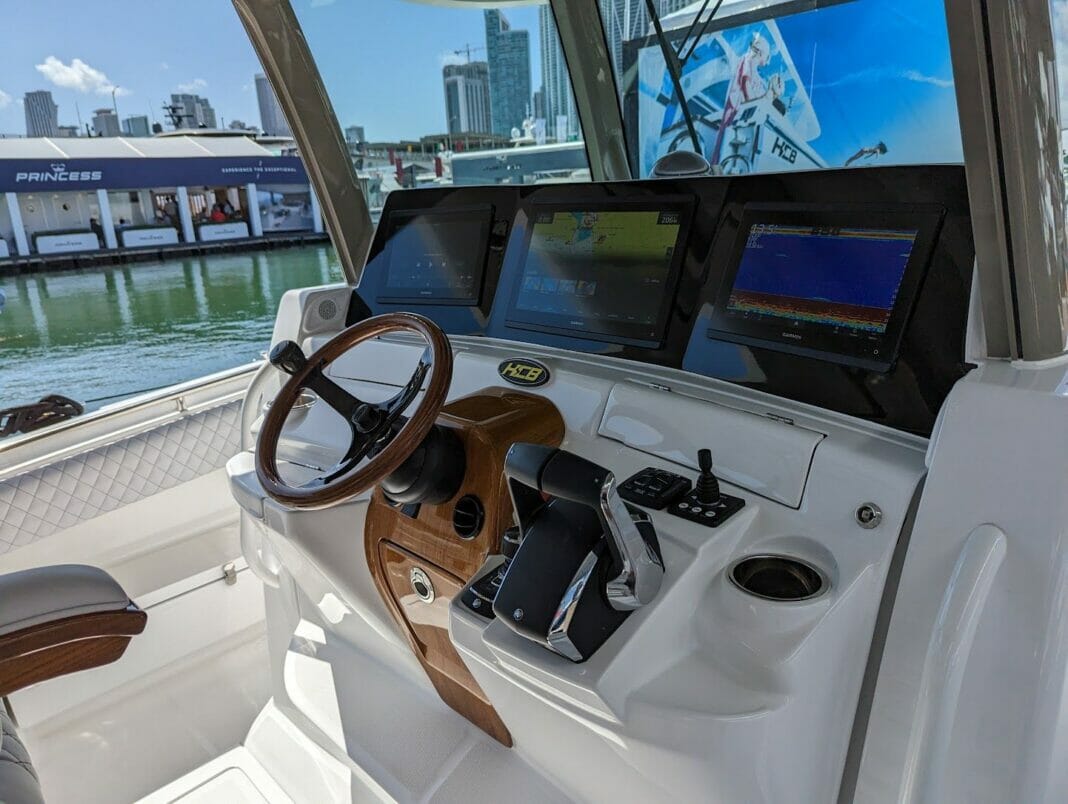
Owning a boat is a significant investment, and the right electronics can help make it safer and more enjoyable for everyone on board. Whether you’re a novice pilot on your first vessel or an experienced captain on a new boat, understanding the different boat electronics and the role they play in improving the performance, safety, and overall experience is essential.
This article will provide an introduction to the basic boat electronics that every boat owner should know. From depth sounders to GPS chartplotters, we’ll cover the essential electronic equipment for any modern boating adventure.
Boat Electronics: Navigation Systems
Navigating a boat through open water is no easy task, especially for beginners. Accurate navigation is vital to ensure the safety of everyone on board and avoid any mishaps due to unpredictable weather conditions, obstacles in the water, or shifting currents. Boat navigation systems have come a long way in recent years, making it possible for even amateur boaters to safely navigate their way to their destination.
GPS Chartplotter
The GPS, or Global Positioning System, is the backbone of any modern navigation system. A GPS chartplotter combines GPS data with electronic charts, allowing you to see your boat’s position and movement on a map. This makes it easier to plan and follow a route or avoid obstacles in the water.
Some modern GPS chartplotters also come with internet connectivity or preloaded maps, so you can access updated charts or points of interest in real-time, providing additional safety and convenience to your boating experience.
A fishfinder is an essential piece of equipment for fishing enthusiasts. It uses sonar technology to detect fish and other underwater objects, helping you find the best spots for casting your line. A fishfinder can also double as a depth sounder, providing information about the water’s depth and seabed’s contours.
While fishfinders are primarily designed for fishing trips, many boaters find them useful for general navigation as well, especially in more challenging or less familiar waters.
Boat Electronics: Communications
Good communication is essential, particularly for safety reasons. Whether you need to notify other boats of your presence or call for assistance, being able to communicate quickly and effectively is crucial.
A VHF (Very High Frequency) radio is the standard communication device on the water. Marine VHF radios operate on specific frequencies reserved for maritime use, allowing you to communicate with other boats, marinas, or even the coastguard.
A fixed-mount VHF radio is the preferred type for most boat owners, while handheld options offer a portable and more affordable alternative. Make sure your VHF radio is waterproof, has a range of at least 25 miles, and is easy to use to guarantee efficient communication.
Boat Electronics: Safety
Various boat electronics enhance safety onboard, offering information, alerts, and assistance when needed.
A radar system can be invaluable on a boat, particularly in poor visibility conditions. Radar detects objects in the water or in the air, providing both navigational and safety benefits. It can help identify nearby vessels, buoys, and land masses, especially during foggy or stormy weather.
AIS (Automatic Identification System)
AIS is a tracking and identification system that uses GPS data and VHF radio transmissions to share your boat’s position, course, and other information with other vessels in the area. This allows you to see the location and movement of nearby boats on a display, improving your situational awareness and reducing the risk of collisions.
Final Thoughts
Understanding basic boat electronics is crucial for the safety, performance, and enjoyment of your boating experience. For beginners, investing in a reliable GPS chartplotter, VHF radio, and AIS system is an excellent place to start. As you become more experienced and confident on the water, you may choose to add advanced equipment like radar or fishfinders to further enhance your boating adventures.
RELATED ARTICLES
Overview of the 2024 sea-doo rxp-x 325, overview of the 2024 parker offshore 2900 cc, what your boat’s beam is and why it matters, power cats of 2024: ultimate guide to the top power catamarans this year, navigating the heat: 10 safety tips for a safe boat ride in the summer heat, latest posts, don't miss, our newsletter.
Get the latest boating tips, fishing resources and featured products in your email from BoatingWorld.com!
What type of wood is used for pier pilings?
What is the difference between a dock and a floating pier, what is the proper technique for pulling a beginner wakeboarder, what does ‘no wake’ mean on a lake, what is the difference between wash and wake, highs, lows, and tidal know-how: a deep dive into ocean currents, 10 essential tips for fishing near private property, the benefits of using a drift sock: guidance for anglers, lure fishing: secrets for imitating live bait and attracting fish, explore the untapped depths of america’s best bass fishing spots, outboard motor maintenance: tips for keeping your engine in top shape, the essential boat tool kit: tools every boater needs, diy boat building: 8 tips and tricks for building your own vessel, the art of miniature maritime craftsmanship: ship in a bottle, antifouling paints: a guide to keeping your boat shipshape, beginner’s guide to standup paddle boarding: tips and techniques, boating for fitness: how to stay active on the water, kayak safety: how to stay safe on the water, anchoring in a kayak or canoe: how to secure your small boat, overview of the 2024 yamaha 252sd, overview of the 2024 tiara yachts 48 le, overview of the 2024 bass cat jaguar sts, 2024 pursuit os 445: an overview, 2024 aquila 47 molokai review, 2024 sea-doo switch 13 sport review, gear reviews, megabass oneten max lbo jerkbait review, fortress anchors fx-7 anchoring system review, fortress anchors fx-11 anchoring system review, fortress anchors commando anchor kit review, fortress anchors aluminum anchors review, stay in touch.
To be updated with all the latest news, offers and special announcements.
- Privacy Policy

Service Locator
- Angler Endorsement
- Boat Towing Coverage
- Mechanical Breakdown
- Insurance Requirements in Mexico
- Agreed Hull Value
- Actual Cash Value
- Liability Only
- Insurance Payment Options
- Claims Information
- Towing Service Agreement
- Membership Plans
- Boat Show Tickets
- BoatUS Boats For Sale
- Membership Payment Options
- Consumer Affairs
- Boat Documentation Requirements
- Installation Instructions
- Shipping & Handling Information
- Contact Boat Lettering
- End User Agreement
- Frequently Asked Questions
- Vessel Documentation
- BoatUS Foundation
- Government Affairs
- Powercruisers
- Buying & Selling Advice
- Maintenance
- Tow Vehicles
- Make & Create
- Makeovers & Refitting
- Accessories
- Electronics
- Skills, Tips, Tools
- Spring Preparation
- Winterization
- Boaters’ Rights
- Environment & Clean Water
- Boat Safety
- Navigational Hazards
- Personal Safety
- Batteries & Onboard Power
- Motors, Engines, Propulsion
- Books & Movies
- Cockpit Confessions
- Communication & Etiquette
- Contests & Sweepstakes
- Colleges & Tech Schools
- Food, Drink, Entertainment
- New To Boating
- Travel & Destinations
- Watersports
- Anchors & Anchoring
- Boat Handling
The Best New Electronics Of 2023
Advertisement
Marine electronics production has been slow the past few years, but the floodgates are now open, leaving consumers awash in innovation.
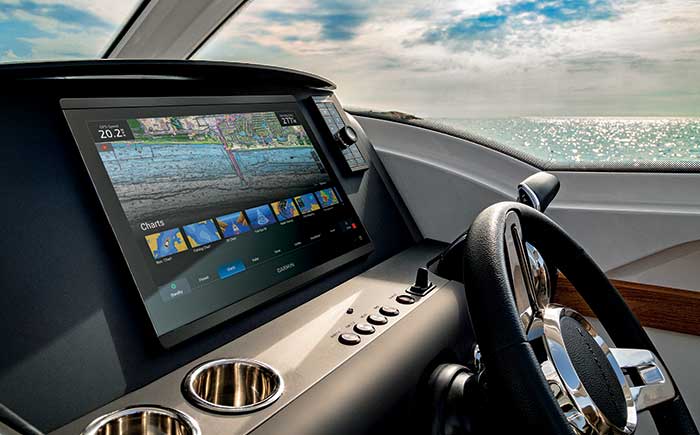
Garmin GPSMAP 8624.
When it comes to the electronics on our boats, we should all know our AC from our DC — but what about PC? No, not political correctness — we're talking post-Covid. Yes, we're well aware the virus hasn't disappeared from daily life, but its role in the marine manufacturing world has diminished significantly. The pandemic led to supply-chain backlogs, leaving manufacturers struggling to meet demand for existing products, much less develop next-generation merchandise. This explains why the introduction of new tech and gear has been sparse these last few years.
We noticed a shift mid-2022 when the well-known brands starting teasing our BoatUS Magazine editors with bona fide innovative stuff. We got a sneak peek from the industry last fall, so as the 2023 season creeps closer, allow us to showcase what's cool, hot, and new in the world of "PC" marine electronics.
Blind Spot Eliminator
Docking a boat can be difficult when you can't see past the bow or across the transom, an issue now addressed with the Garmin Surround View Camera System. Stitching together the view from six different cameras, Surround View gives you 360-degree views at the helm, and creates a live "bird's-eye" view looking down on your boat. You can also set a "visual bumper" indicator on the screen so you know when a dock, pier, or another boat is about to violate a preset barrier limit. Distance markers also help ascertain exactly how close your boat is getting to any object and, if desired, you can pull up each camera's view individually. OEM, so look for pricing as an option on a new boat | Garmin.com
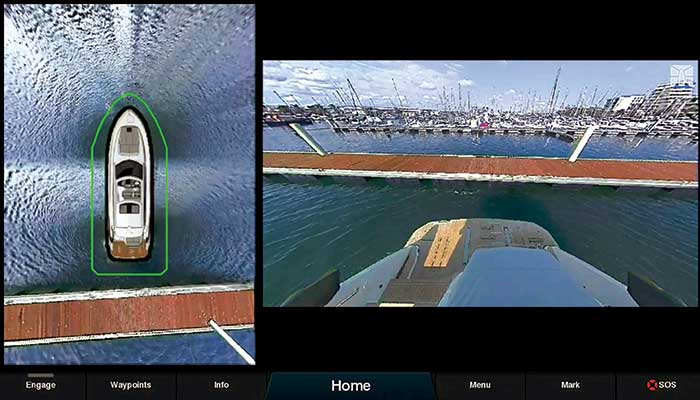
Garmin Surround View Camera System provides eyes in the back of your head.
Color & Clarity
Navionics digital cartography is known for its level of detail and ease of use. Garmin bought the mapmaker in 2017, but only now has fully integrated Navionics charts across its entire line of Garmin GPSMAP units (look for Garmin Navionics+ and Garmin Navionics Vision+). From the diminutive 743xsv to the movie-screen-like 8624 models, these now come with Navionics inland and coastal mapping built in. The color palettes and interface have been tweaked to provide improved detail and visibility. Also new are auto-routing capabilities, and color-shaded depth ranges with up to 1-foot contour detail. $1,099 to $12,299 | Garmin.com
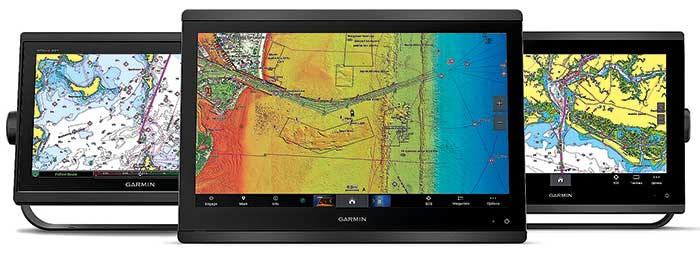
The entire Garmin GPSMAP line now comes with standard Navionics cartography.
See Through Salty Seas
Garmin's LiveScope virtual real-time imaging changed the way freshwater anglers fish and allowed them to spot fish beneath the surface with such detail that it became possible to judge the species and its size long before taking a first cast. The downside? Because of very limited range in saltwater environments, it didn't do much for coastal and oceanic anglers. LiveScope XR solves that problem. Using the GLS 10 black box, a LVS62 transducer, stabilizers to mitigate the effect of waves, and multiple color patterns, you can probe the brine out to 350 feet. Freshwater anglers also benefit with LiveScope XR, as a previous range of 200 feet can be extended out to 500 feet. Boats with bow-mounted electric trolling motors (which act as the transducer mount) will find the most utility from this system. Rigs with an existing GLS 10 can be upgraded to XR with a (free) software update and the LVS62 transducer. $2,999.99 | Garmin.com
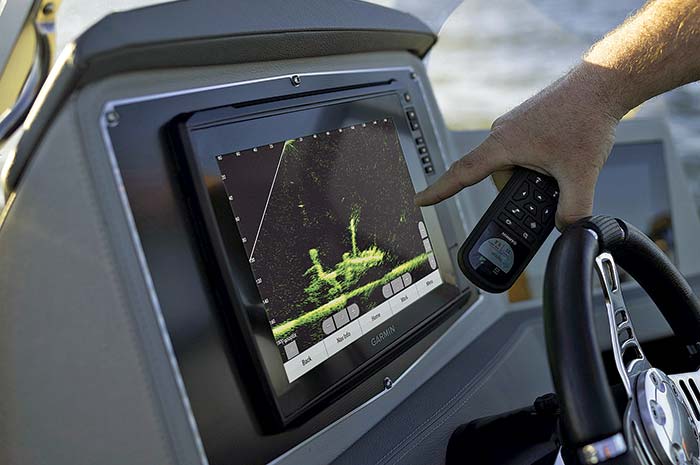
Saltwater anglers can see through the brine out to 350 feet with LiveScope XR from Garmin.
Power To The People
What's the best thing about not having a generator? Not having to listen to the rumble and grumble of a generator. Still, we need our power. Navico Group's Fathom lithium-ion power management system aims to provide ample juice to run everything from air conditioning to galley appliances via a combination of power conversion and distribution, digital switching, and control/monitoring, with powerful lithium-ion batteries at the heart of the system. It's available in 12-, 24-, and 48-volt systems for boats ranging from 27- to 35-plus feet, and can be controlled with an app on your smart device. Preconfigured kits are scheduled to launch through 2023. OEM product (look for it as a new-boat option), or available as custom kits ranging from $1,000 to $17,000+ | Navico.com
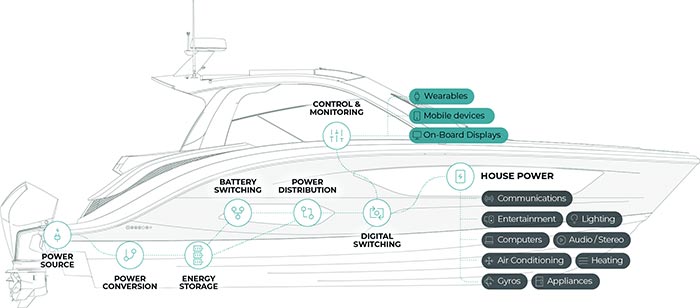
The new Fathom lithium-ion power management system does it all.
Old Boat, New Tricks
Joystick controls have made life easier for many boaters when it comes to virtual anchoring, close-quarters maneuvering, and docking. But most of the systems out there are intended for outboards, sterndrives, and pod drives, leaving lots of boaters with straight-shaft inboards to go without. Twin Disc has a new solution with Express Positioning, which is compatible with boats incorporating single or twin inboards plus hydraulic thrusters. ABT-TRAC TRAC-Link and Side Power S-Link thrusters at the bow or both bow and stern are integrated with the inboard's transmission(s) to hold your boat in place or make micro-adjustments to its position, even in high wind and/or high-current conditions, while a full-color display provides an interface showing position, system status, and operational parameters. Price varies by installation | TwinDisc.com
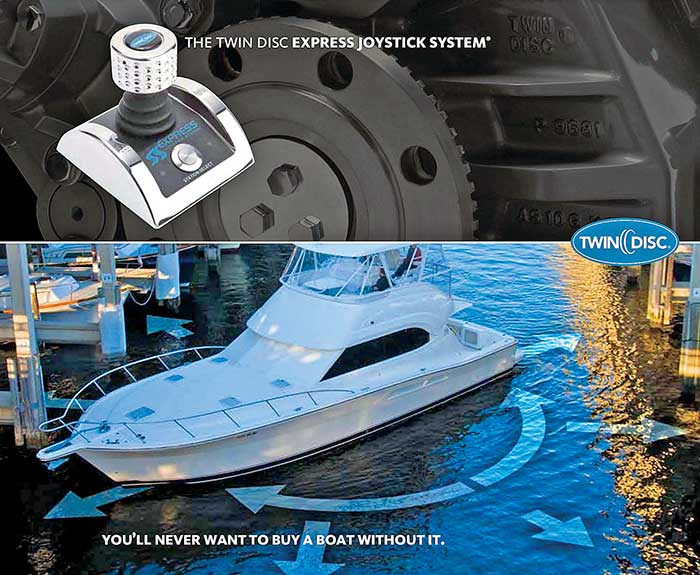
Twin Disc figured out how to add joystick control to straight-shaft inboards.
Stay In Touch
Having full connectivity once meant you needed multiple antennas, had to manually switch between carriers to maintain connectivity, and had no idea how much data you were chewing through until that eye-popping bill arrived in the mail. The KVH TracPhone LTE 1 aims to solve those problems, packing a high-gain dual LTE-A antenna array, modem, GPS, and Wi-Fi router into a 6.25-pound, 13.5- by 13.3-inch dome. KVH promises you can pull in cell coverage when over 20 miles from the nearest cell tower (with antenna mounted 20 feet above the waterline) and enjoy faster-than-4G data speeds with automatic switching between carriers and multi-device connectivity.
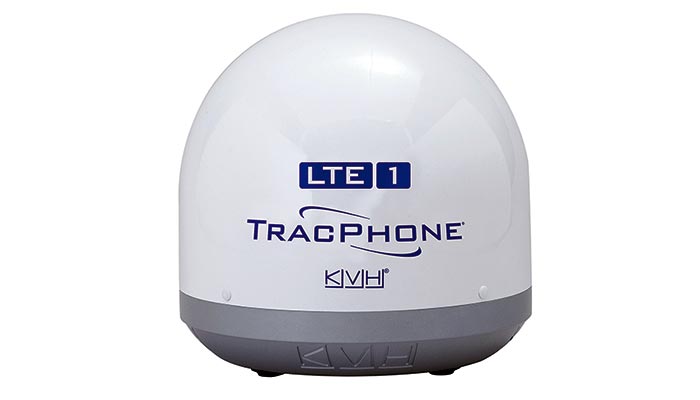
TracPhone LTE-1 packs satellite, cellular, Wi-Fi, modem, and GPS into one dome.
The LTE Manager App allows you to see your data usage at any time. You can also set usage alerts via text or email, so you get a heads-up long before those bills arrive. $1,595 | KVH.com
For Some Perspective On Pricing
What's the most significant development in the world of marine electronics since the turn of the century? You can make arguments for total system integration; simpler, intuitive user interfaces; or the advent of touchscreens. But if you measure "most significant" in terms of impact on the greatest number of boaters, the development to focus on is probably the massive increase in bang-for-your-buck. Flash back to the dawn of the 21st century: Today's relatively inexpensive midrange multifunction displays (MFDs) have the capabilities of full-blown nav suites that would have cost tens of thousands of dollars back in 2000.
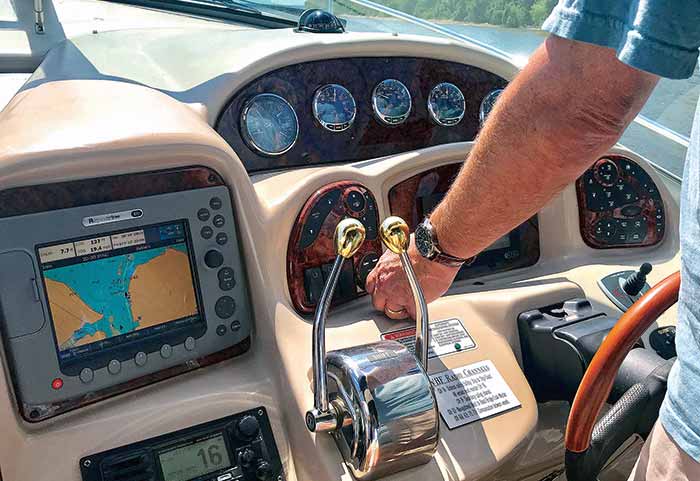
Then. (Photo: Rich Armstrong)
Remember back when everyone was freaking out over the Y2K bug that might crash all computers at the end of 1999? If you wanted complete navigational nirvana, you'd have spent $6,500 for a 10-inch color chartplotter with differential GPS (Northstar 961); $200 for a halfway decent chart chip (C-Map NT); $2,000 for a standard-issue 6.4-inch color fishfinder (Lowrance LCX-16CI); $3,000 to get a dinky entry-level standalone radar with a 6- to 8-inch LCD display (Furuno 1712); and $3,200 for an autopilot (Raymarine ST6001, core pack and drive unit). In total, you were looking at around $15,000 for a complete system — installation not included!
Today, you can get a Raymarine Element HV 12-inch full-color touchscreen LCD with twice the resolution of the vintage 2000 screens and all the listed accessories above for around $7,500. Your fishfinder now has 3D, side-scan, down-scan, and CHIRP (all distant dreams in 2000). You'll also have AIS display capability (yet to exist for the old package) and a long list of abilities that also weren't commonly seen at the turn of the century, such as overlaying your radar over your chartplotter, splitting multiple screens between chartplotter and fishfinder, bringing up engine data on your MFD, and so on. A complete package with the Garmin GPSMAP 1242xsv package, Lowrance HDS-12 LIVE, Simrad GO 12XSE, or Furuno TZTL12F all swim the same pricing and packages waters, and come in under the $10,000 mark.
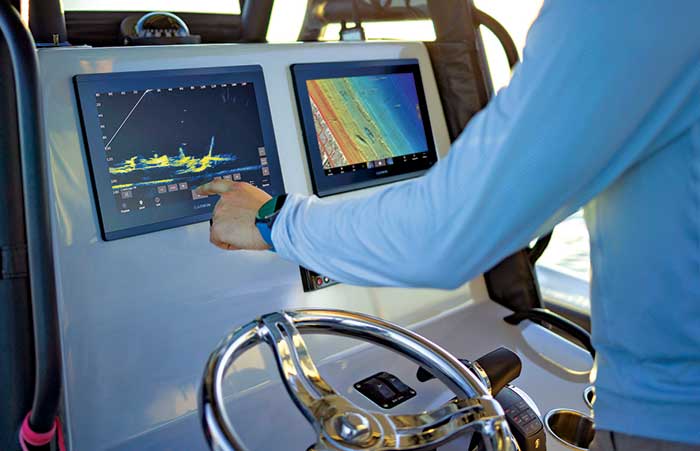
Now. (Photo: Rich Armstrong)
So let's use $15,000 versus $7,500 as our impressive comparative price drop by 50% for what today constitutes a mid-level marine electronics system. And that understates all the value-added features and functionality we get out of today's systems. So for the broadest swath of the boating public, the bottom line is that the single, most-impactful change in marine electronics since the turn of the century is an impressive decrease in cost.
Related Articles
The truth about ceramic coatings for boats.
Our editor investigates the marketing claims of consumer-grade ceramic coatings.
Fine-Tune Your Side Scan Fishfinder
Take your side-scanning fishfinder off auto mode, and you’ll be spotting your prey from afar in no time
DIY Boat Foam Decking
Closed-cell foam flooring helps make boating more comfortable. Here’s how to install it on your vessel
Click to explore related articles
Lenny Rudow
New Boats, Fishing & Electronics Editor, BoatUS Magazine
Top tech writer and accomplished sports fisherman, BoatUS Magazine Contributing Editor Lenny Rudow has written seven practical boating books, won 30 awards from Boating Writers International — many for his marine electronics articles – and two for excellence from the Outdoor Writers Association of America. He judges the NMMA Innovation Awards, and is Angler in Chief at FishTalk, his own Chesapeake-based publication. A great teacher and inspirational writer, Lenny hosts many of BoatUS Magazine’s very-popular how-to videos, which can be found on the BoatUS YouTube channel, or at BoatUS.com
BoatUS Magazine Is A Benefit Of BoatUS Membership
Membership Benefits Include:
Subscription to the print version of BoatUS Magazine
4% back on purchases from West Marine stores or online at WestMarine.com
Discounts on fuel, transient slips, repairs and more at over 1,200 businesses
Deals on cruises, charters, car rentals, hotel stays and more…
All for only $25/year!
We use cookies to enhance your visit to our website and to improve your experience. By continuing to use our website, you’re agreeing to our cookie policy.
- You are here
- Everything Explained.Today
- A-Z Contents
- Motorboating (electronics)
Motorboating (electronics) explained
In electronics , motorboating is a type of low frequency parasitic oscillation (unwanted cyclic variation of the output voltage) that sometimes occurs in audio and radio equipment and often manifests itself as a sound similar to an idling motorboat engine, a "put-put-put", in audio output from speakers or earphones. [1] [2] [3] [4] It is a problem encountered particularly in radio transceivers and older vacuum tube audio system s, guitar amplifier s, PA systems and is caused by some type of unwanted feedback in the circuit. The amplifying devices in audio and radio equipment are vulnerable to a variety of feedback problems, which can cause distinctive noise in the output. The term motorboating is applied to oscillations whose frequency is below the range of hearing, from 1 to 10 hertz , so the individual oscillations are heard as pulses. Sometimes the oscillations can even be seen visually as the woofer cones in speakers slowly moving in and out.
Besides sounding annoying, motorboating can cause clipping of the audio output waveform, and thus distortion in the output.
Although low frequency parasitic oscillations in audio equipment may be due to a range of causes, there are a few types of equipment in which it is frequently seen:
- Older audio amplifiers with capacitive (RC) or inductive (transformer) coupling between stages. [5] [6] [7] [8] This design is mostly used in vacuum tube (valve) equipment. Motorboating was a problem throughout the era of vacuum tube electronics but became rare as vacuum tube gear was replaced in the 1970s with modern solid state designs, which are direct-coupled . The recent resurgence in popularity of traditional tube-type audio equipment in guitar amplifier s and home audio systems has led to a reappearance of motorboating problems. The problem is sometimes caused in older equipment by the evaporation of the electrolyte from old-style "wet" electrolytic capacitor s used in the power circuits of legacy equipment, or in equipment of any age where an amplifier stage is sensitive to feedback via power supply rails , and can be remedied by replacing/upgrading the capacitors.
- In both old and new designs, even mostly directly-coupled operational amplifier circuits, feedback through the power supply rails can generate ultrasonic oscillations that vary in amplitude at a low frequency ( squegging ) due to the power supply voltage sagging as oscillations build up (the long time constant coming from the power supply reservoir capacitor) in such a way that the low frequency is audible even though the high frequency fundamental is not. Such problems can be difficult to diagnose. [9] [10]
- Audio equipment associated with radio transmitters , particularly transceiver s in two way radio s, such as Citizens band , FRS , which have automatic gain control (AGC) or squelch noise control. Malfunctions in the AGC or squelch circuits, which have long time constant s, can cause low frequency oscillation. Another possible cause, sometimes in combination with the first, is leakage of the strong radio frequency (RF) signal from the transmitter into the receiver audio sections, which can cause quenching oscillations. This is a RFI problem, caused by inadequate shielding or filtering to keep the RF out.
As with all electronic oscillation , motorboating occurs when some of the output energy from an amplifying device like a transistor or vacuum tube gets coupled back into the input circuit of the device (or possibly into an earlier stage of the amplifier circuit) with the proper phase for positive feedback . This indicates there is an unwanted feedback path through the circuit from output to input of an amplifying stage. The technical conditions for oscillation, given by the Barkhausen stability criterion , are that the total gain around the feedback loop (comprising the amplifying device and the feedback path) at the oscillation frequency must be one (0 dB), and that the phase shift must be a multiple of 360° (2π radian s). Since most amplifying devices, transistors and tubes, are inverting, with the output signal 180° opposite in phase from the input, the feedback path must contribute the other 180° of shift.
Many types of parasitic oscillation are caused by small interelectrode capacitance s ( parasitic capacitance ) or mutual inductance between adjacent wires or electronic components on the circuit board, which create an inadvertent feedback path. However these usually cause oscillations of high frequency , at the upper end of or above the passband of the equipment. This is because the phase shift of the small reactances in the feedback path, which increases with frequency, only become significant at high frequencies. Low frequency oscillations like motorboating indicate that some device or circuit with a large time constant is involved, such as the interstage coupling capacitors or transformers, or the filter capacitors and supply transformer winding.
In vacuum tube circuits, a common cause is feedback through the plate power supply circuit. The power supply provides DC current to each tube's plate circuit, so the power supply wiring (power busses) can be an inadvertent feedback path between stages. The output (plate) impedance of the diode vacuum tube rectifiers in the power supply is high, so the increasing impedance of the filter capacitors at low frequencies can mean that low frequency swings in the current drawn by output stages can cause voltage swings in the power supply voltage which feed back to earlier stages, making the system a subaudio oscillator. This is caused by inadequate power supply filtering or decoupling. The electrolytic capacitors used in equipment of 1960s vintage contained liquid electrolyte, which dried out over decades, decreasing the capacitance and increasing the leakage current, and these are often the cause.
One solution suggested is a "capacitor job", replacing all the old electrolytic capacitors. [11] A more radical but comprehensive solution is to add modern IC voltage regulator s, or replace the entire power supply with a modern regulated one.
Basic Boat Electronics for Beginners
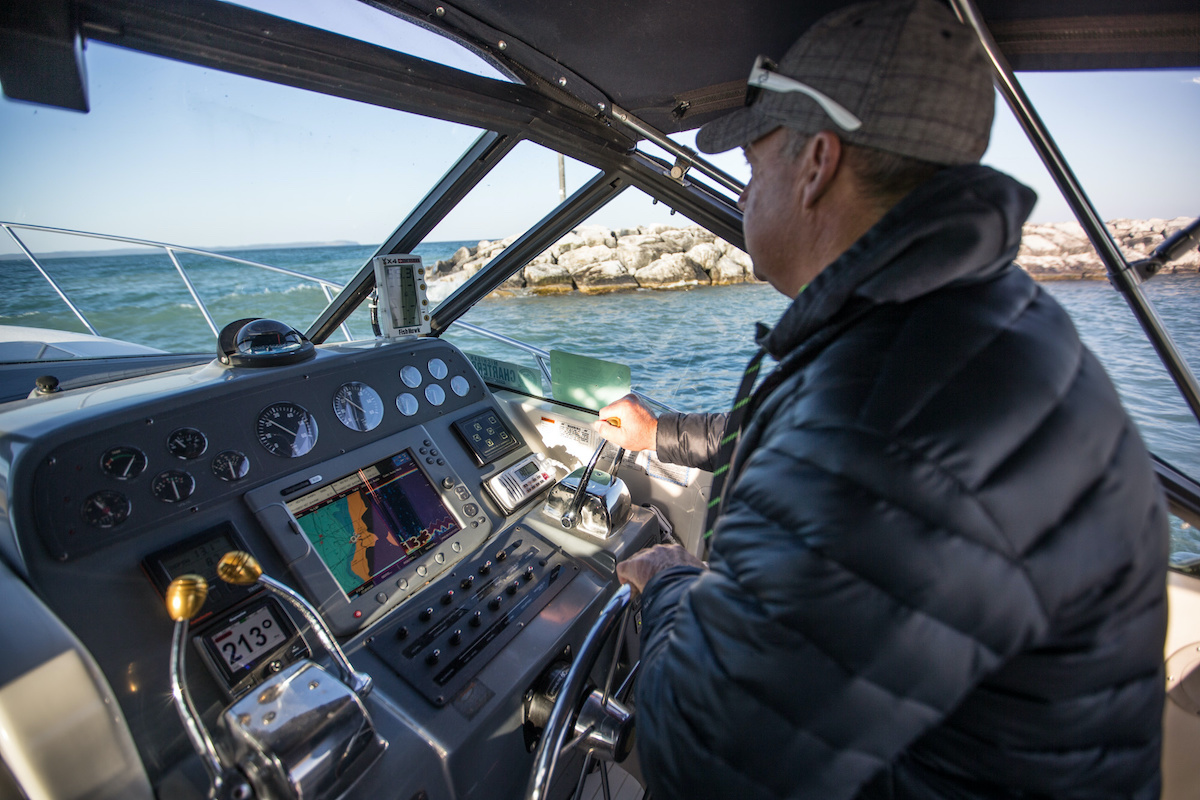
Learning about boat electronics may seem a bit daunting, but the tech at your helm will help make running and navigating your boat easier than ever. Thanks to modern marine electronics and navigational instruments , captaining your boat is far less complex and confusing than it once was.
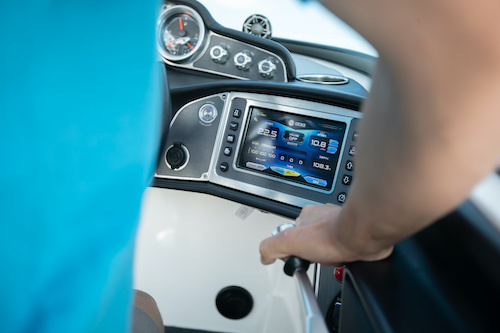
In fact, electronics have taken tasks like navigation , which once required years of learning to master, and made them as simple as pressing a few buttons or swiping on a touch screen. There are still some rather complex tasks and gear involved when one considers operating some large vessels, but for the average recreational boat owner the list of electronics you’ll need to learn about is relatively short.
What boat electronics do I need onboard?
Multifunction displays (mfds).
- GPS/Chartplotter
Fish Finder or Depth Sounder
Engine monitors.
How to Navigate a Boat
Think of multifunction displays, commonly called MFDs, as the “brain” for your boat. They incorporate most or even all of your systems into one single interface, which may feature either a touch screen or keypad control.
While it may seem overwhelming to think about combining all the different systems into one, don’t fret. MFDs are shockingly easy to learn how to use because most modern versions utilize a user-interface that’s very similar to the smart phone sitting in your pocket. You’ll discover that home screens have pages with app-like, tap-to-activate icons that allow you to choose between functions, and customizable pages that allow you to bring combinations of different functions up in split-screen modes.
If you’re just buying a new boat that incorporates the latest and greatest technology, you may discover that the MFD controls not only the marine electronics, but also all of the boat’s electrical systems. This ability comes courtesy of tech called “digital switching.”
Digital switching allows you to turn any device on or off right from the MFD screen (think of it like Nest for your boat). So when a boat is built with a digital switching system things like the light switches, livewell pumps, electric windows, and anchor windlasses can all be controlled with a tap or a swipe of your finger on the MFD.
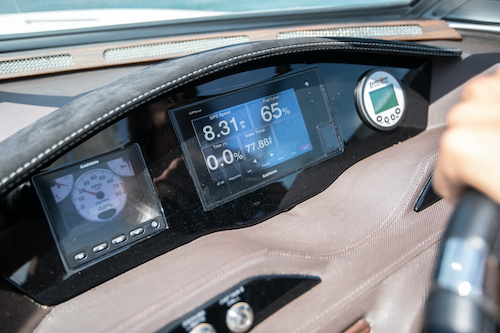
GPS/Chartplotters
You’ve almost certainly enjoyed the benefits of GPS mapping on your phone and in your car. Just as this tech has made driving around on land a lot less confusing, it’s made navigating a boat a snap. You may navigate with a stand-along GPS/chartplotter, the GPS/chartplotter function on your MFD, or even via an app on your phone or tablet (see 5 Best Marine Navigation Apps for Boaters , to find the right nav app for your needs).
In truth, there really isn’t a huge difference between navigating a boat with a GPS/chartplotter and navigating a car with GPS mapping. No, there are no roads and yes, you have to be aware of factors like water depth, navigational aids, and hazards to navigation. But the basic concept is quite similar and once you’ve checked out Marine GPS for Boats: Understanding the Basics , and Marine Navigation: How to Navigate a Boat , you should find that when it comes to figuring out simple navigational techniques the learning curve is quite short.
Marine GPS for Boats: Understanding the Basics
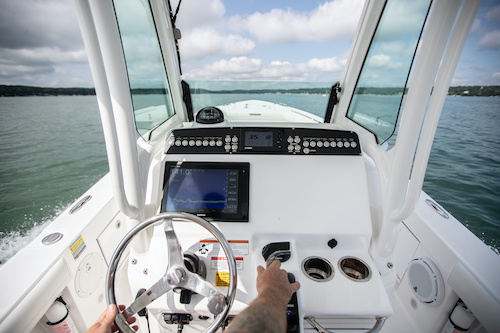
Fish finders and depth sounders are also functions that are built into most MFDs but may be found as stand-alone units as well, particularly on small all-purpose fishing boats , center consoles , and other boats designed for fishing which don’t necessarily have larger, more expensive electronics systems installed.
They may have touch-screen or tactile interfaces, and generally have a number of settings that can improve performance quite a bit depending on factors like water depth, the level of suspended solids in the water, zoom levels, and so on. Fortunately, all modern fish finders have “auto” modes that can do most of the fine-tuning for you.
Ready to dig a bit deeper into the details?
How to Use a Fish Finder
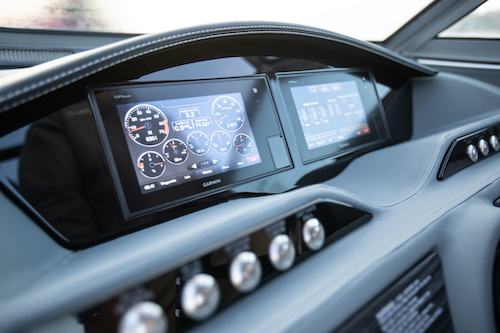
Engine monitors provide you with digital gauges like tachometers, fuel level, and engine temperature. Once again, this functionality may come through your MFD or you may have dedicated screens to show you nothing but engine data. In this case, however, having dedicated screens is more common because you’ll want to be able to monitor your powerplants whenever they’re running.
Engine monitors can take up a lot of screen space on an MFD, leaving less room for other systems to be viewed. And they usually need to be used simultaneously with things like chartplotters and fishfinders. So most of the time, engine monitors will have their own stand-alone screens.
Just about all of us are used to seeing digital gauges in the dashboard of our cars and trucks, so you should have zero problem adapting to using them in your boat. Just remember that with a boat there are often more variables to consider, and engine monitors may include things like drive trim level or rudder angle in addition to basic engine data.
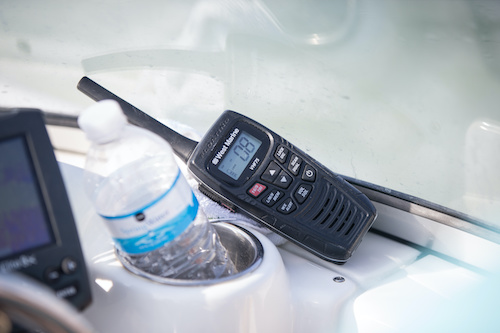
Of all the electronics on your boat, the VHF radio is one of the most important. It’s a critical piece of safety gear and the most reliable way to communicate with the authorities in case of emergency. Yes, we all carry cell phones these days, but cell service can get sketchy on many waterways and cell phones are prone to water damage.
Your VHF radio, on the other hand, is the best way to reliably get a call for help through to the authorities in any place or situation. VHFs are relatively simple to operate, so read through How to Use a VHF Radio and familiarize yourself with the process.
How to Use a VHF Radio

Explore Other Boat Electronics
What about all those more advanced systems found on larger boats, like autopilots, radar, or EPIRBs? We have info about them, too, which you can find below. But for the average boat owner, our short-list will cover all the bases. Learn how to use your MFD, GPS/chartplotter, fish finder or depth sounder, engine monitors, and VHF radio, and you’ll be ready to hit the water and enjoy some fun in the sun with confidence.
- To learn more about autopilot systems, see Autopilot/Self-Steering Gear .
- To learn about marine radar systems, see Boat Radar, Marine Radar, and Broadband Radar .
- To learn more about EPIRBs, see EPIRBs - You Bet Your Life .
Read Next: Best Boating Apps for Navigation, Fishing, Weather & More
You May Also Like:
- 10 Best Fishing Apps for Your Smartphone
- Boat Trip Checklist: 10 Things You Need on a Boat
- How to Drive a Boat
- Owning & Operating Guide
- Find the Right Boat for Your Lifestyle
Join Our Newsletter!
Get community news, buying bargains, and how-to guides at your fingertips.
About: Motorboating (electronics)
In electronics, motorboating is a type of low frequency parasitic oscillation (unwanted cyclic variation of the output voltage) that sometimes occurs in audio and radio equipment and often manifests itself as a sound similar to an idling motorboat engine, a "put-put-put", in audio output from speakers or earphones. It is a problem encountered particularly in radio transceivers and older vacuum tube audio systems, guitar amplifiers, PA systems and is caused by some type of unwanted feedback in the circuit. The amplifying devices in audio and radio equipment are vulnerable to a variety of feedback problems, which can cause distinctive noise in the output. The term motorboating is applied to oscillations whose frequency is below the range of hearing, from 1 to 10 hertz, so the individual osci
| Property | Value |
|---|---|
| abstract | |
| wikiPageID | |
| wikiPageLength | |
| wikiPageRevisionID | |
| wikiPageWikiLink | :Amplifier :Electrolyte :Electrolytic_capacitor :Electronic_oscillation :Electronics :Passband :Transceiver :Vacuum_tube :Decoupling_capacitor :Electrolytic_capacitors :Reservoir_capacitor :Citizens_band_radio :Electrical_impedance :Frequency :Motorboat :Phase_shift :Clipping_(audio) :Phase_(waves) :Public_address_system :Time_constant :Distortion :Gain_(electronics) :Citizen's_band_radio :Feedback :Feedback_loop :Barkhausen_stability_criterion :Family_Radio_Service :Woofer :Positive_feedback :Power_supply :Radio_frequency :Voltage_regulator :Radio_electronics :Transistor :Automatic_gain_control :Filter_capacitor :Guitar_amplifier :Operational_amplifier :Capacitance :Radian :Squelch :Ultrasound :Transmitter :Power_supply_rejection_ratio :Two-way_radio :Parasitic_capacitance :Parasitic_oscillation :Squegging :Solid_state_(electronics) :Two_way_radio :Radio_frequency_interference :Direct_coupled_amplifier :Audio_system :Mutual_inductance :Hertz_(unit) |
| subject | :Radio_electronics |
| hypernym | :Oscillation |
| comment | |
| label | |
| sameAs | :Motorboating (electronics) :Motorboating (electronics) :Motorboating (electronics) |
| wasDerivedFrom | :Motorboating_(electronics)?oldid=944755034&ns=0 |
| isPrimaryTopicOf | :Motorboating_(electronics) |
| is wikiPageDisambiguates of | :Motorboating_(disambiguation) |
| is wikiPageWikiLink of | :Motorboating_(disambiguation) :EMC_problem_(excessive_field_strength) :OCL_amplifier :Loop_bin_duplicator :Power_supply_rejection_ratio :Parasitic_oscillation :Squegging |
| is primaryTopic of | :Motorboating_(electronics) |


- Search forums
- Scanners, Receivers and Related Equipment Forums
- New User / Getting Started Forum (Closed)
What is mean by "motorboating"?
- Thread starter sadatoni
- Start date Jul 10, 2010
- Jul 10, 2010
What is mean by "motorboating"? I see it mentioned often, but cannot find a definition.
Motorboating to me is digital trunking signals on a analog scanner. Mark
In my experience, when people complain about "motorboating", they're referring to a scanner receiving a digital voice transmission (e.g. P25 CAI voice) but not decoding it as "digital" - instead playing the undecoded digital noise as if it was an analog voice transmission. For example, a Motorola trunked system (3600bps control channel) on which some or all of the voice transmissions are digital. Unless explicitly programmed otherwise, the scanner has to wait for a short time at the beginning of each voice transmission, in order to determine if that transmission is digital or analog. If it's really a digital transmission, but the scanner "misses" that fact, you'll hear the undecoded digital noise: "motorboating". Another example: a non-trunked (conventional) P25 CAI voice frequency that isn't explicitly forced to digital mode (e.g. by telling the scanner, in some way, that it's digital - like programming a NAC value), or which is erroneously programmed as "analog" (e.g. by programming a DCS or CTCSS value). In the first case, the behavior would be like the trunking example above; in the second case, the scanner will always give you the digital noise, since you've told it it's "analog" (presuming the CTCSS / DCS programming doesn't "gate" the audio). You'll always get this behavior on an analog scanner programmed with such systems or frequencies. It's possible to get it on a digital scanner, as well, depending on signal quality, scanner settings, etc.
Thanks. I kind of thought it was a digital signal showing up in an odd places.
- Jul 11, 2010
"motorboating" is a low frequency oscillation that resembles a motorboat putt-putting along. The term predates anything digital by about 6 decades or so.
- Jul 15, 2010
zz0468 said: "motorboating" is a low frequency oscillation that resembles a motorboat putt-putting along. The term predates anything digital by about 6 decades or so. Click to expand...
cpsTN said: Did motorboating have the same meaning BEFORE digital, but not caused by digital apparatus? Click to expand...
- Jul 17, 2010
cpsTN said: As far as you sig, I now know why I keep running into buildings when I drive! Click to expand...
Similar threads
- Aug 2, 2024
- Uniden Tech Discussion
- Aug 11, 2024
- Harris / MA/COM / GE / Ericsson Forum
- Aug 8, 2024
- New Jersey Radio Discussion Forum
- Aug 1, 2024
- Voice/Control Channel Decoding Software
- Aug 6, 2024
- BOAT OF THE YEAR
- Newsletters
- Sailboat Reviews
- Boating Safety
- Sails and Rigging
- Maintenance
- Sailing Totem
- Sailor & Galley
- Living Aboard
- Destinations
- Gear & Electronics
- Charter Resources
- Ultimate Boat Giveaway

Upgrading Your Boat Electronics
- By Ralph Naranjo
- Updated: November 6, 2014
Modern boat electronics provide a great benefit to sailors when it comes to navigation, weather, collision avoidance or just the plain fun of being under sail. So it’s no surprise that we cruisers regularly add to our gadget list, often mixing brands and coupling old with new. Often this raises compatibility issues, some of which lead to creative work-arounds and others to outright failure.
This mix of labels and vintages was all just fine in the stand-alone era, when a black box wasn’t lurking somewhere below, taking in data from an array of output devices and spewing it out to screens scattered from bow to stern. Oh, for the days when the chart plotter had yet to become today’s multifunction display! Some would even say that retaining this “stand-alone” mind set, where each unit has its own power cable, display and electronic autonomy, is the right answer when it comes to coping with a mix-and-match multibrand nav station. However, there are other options for boat electronics.
With the proper cables and devices, today it’s possible to interface an array of onboard instruments and enhance their ability to share a common data stream. These inputs can come from the masthead anemometer, the depth sounder transducer in the bottom of the bilge, or anything in between. This digital dialogue, at its most basic, relies on a stream of bytes running through special cables at nearly the speed of light. All are ducted to a controller area network (CAN bus) — a bit of automotive brilliance put to good use in the marine industry. Those with older, but not quite antique, boat electronic gear can sometimes use an instrument’s NMEA 0183 data feed to “talk” with more modern NMEA 2000-compliant devices, or even employ an analog-to-digital signal converter to breathe new life into older components. But the more esoteric the networking solution becomes, the bigger the bill and the more poignant the question: Is it really worth it?
To get a good answer, I spoke with boat electronics pro Bob Campbell of Annapolis, Maryland, who had sage advice when it comes to electronically interfacing a diverse gaggle of gadgets. His first priority is helping the boat owner consider electronic gear as a navigation system rather than individual components. Before focusing on specific brands, the next step is to develop a realistic two-column list of gear under the headings “Must Have” and “Might Want.”
Once that’s completed, Campbell’s advice is to steer clear of brand hopping to minimize the need to lash one manufacturer’s equipment to another’s network. Carefully consider the value, cost savings and reliability that come from brand allegiance. Focus on the essentials and go with the gear line that hits the most points in the Must Have column.
Admittedly, Campbell does a lot of “transmutations,” often turning an analog signal from older equipment into digital compliance, but it can be a costly and complicated process. He often reminds owners that there’s a point where Kenny Rogers’ “fold ’em” theory is the best way to play your hand.
When the right tack is a clean sweep to a new system, Campbell says, the result is faster processor(s), higher resolution, more user-friendly MFD, plus better reliability and more flexibility. A good resource when it comes to planning an electronics makeover is the manufacturers themselves. Many have already included some backward compatibility in their new gear, and can answer questions about which of their black boxes will converse with previously installed units. Naturally, they’d prefer you buy a whole new system, and that may be the best solution in the long run. But you can take baby steps: If you are pleased with the mainstay of the gear in your nav station, a partial upgrade can be a smart move.
Bring your lingering questions to a local or regional boat show to chat with a factory-trained technician familiar with your gear. A very typical questions is “Can I network my older wind instruments with my new MFD?” If the units are from the same manufacturer the answer is probably yes, but if interfacing requires more complex custom analog-to-digital signal conversion, it’s likely time to consider a wind-instrument upgrade or live with the apparent wind direction and speed as stand-alone data.
DIY Advice from the Pros
For those tackling their own electronics installations, there’s nothing more informative than watching a skilled team of pros go through a complete electronics refit. When I met with the crew of Annapolis-based Marine Electric Systems they were in the midst of a major makeover on a complicated 55-foot uber-networked cruising boat. The project was a lesson in how to set up a complicated network, and where the big challenges lie. Strict attention to detail was the underlying refrain. The crew crimped dozens of connections; securely sealed network cable plugs; and merged the antenna, digital compass and autopilot feedback leads. Little things like a loosely crimped connection could lead to moisture intrusion, corrosion and a changed impedance — a combination that’s not always easy to find and can cause lingering problems.
Campbell and crew stressed the importance of an owner’s developing a viable electronics game plan, one in which the operational goals merge with what’s technically achievable. In this case, the installation included an Ethernet, NMEA 0183/NMEA 2000 and proprietary cabled network with enough expansion capacity to cope with additional equipment. A sky’s-the-limit options list included dual GPS and GLONASS (the Russian equivalent of GPS) position inputs, and radar, AIS, weather and FLIR data streams can be overlaid on digital charts. There was also a desire to display this avalanche of information on large-format screens and on multiple displays. Fortunately, on this boat at least, the bad habit of breaking a 7-inch MFD screen into three sections to show cartography, a radar image and boat stats wasn’t considered. (In such situations, essential detail is hidden by the diminutive size of the screen.)
By the refit’s conclusion, it was clear that today’s top-end electronics installers have engineering and technical skills akin to what you’d find in the aviation industry. For the DIYer, there’s a lot to be learned.
As system complexity grows linearly, networking demands expand exponentially. For the self-reliant cruiser, consider limiting your needs to a fairly simple two-station system, and commit to single-brand allegiance. Installation becomes much easier and keeps the challenge of maintenance and operation within your grasp. If you have champagne tastes and a budget to match, find a skilled pro, work out a detailed quote and invest in a job well done.
The Screens Are Just the Start
When embarking on an electronics upgrade, remember that the retail price for the components is just the beginning. Each manufacturer has its own network architecture and proprietary waterproof cabling, control nodes, junction boxes, rate gyros, antennas, etc. The cost of options and the need for complex cabling increase with the number of peripherals to be networked. If planning a do-it-yourself project, look at the online installation manuals of the prospective gear. Most hardware comes with bracket mounts that eliminate the need for complex recessed joiner work. Even cockpit installations can be done using pre-manufactured pedestal-mount boxes, saving time and the need for special carpentry or fiberglass fabrications.
The really big-screen “glass helm” extravaganza seen on many motor yachts is a wonderful aid to navigation, but it’s overkill on the average cruising sailboat. The daily current consumption of such a system can be greater than the load your refrigeration places on the house battery bank. This means running the engine while you’re under sail in order to create power for the nav station. Part of the big-picture planning process is ensuring that the energy appetite of your networked electronics is in keeping with your boat’s battery bank. Engineering into the system an ability to turn individual equipment on and off — for example, to be able to run the depth sounder and chart plotter without activating unnecessary components in the network — is a big plus. After all, that’s exactly what you could do with the stand-alone architecture, an approach that still has a reasoned and vocal following.
Like many other sailors, I find myself overly attached to familiar equipment. Though I long ago switched to GPS, it took the U.S. Coast Guard’s curtailing Loran signal transmissions to get me to finally retire the receiver. Until recently, I’d held the same commitment to advocating for stand-alone electronic equipment. Aboard our sailboat, Wind Shadow, electronic simplicity had meant a GPS, sounder and conventional piloting/paper chart routine. But I finally made the transition, and wondered why I had waited so long. I like to think of this as a fully considered commitment to technology — not a borderline Luddite complex. Either way, I made a clean-sweep upgrade and did the work myself. The nav station on Wind Shadow now sports a 12-inch MFD chart plotter/radar combo that juggles a GPS signal, depth sounder input and a rate gyro signal to make the autopilot happy. I have leveraged one manufacturer’s components, cabling and installation wisdom. On the horizon is a smaller MFD for the cockpit.
Previously, I’d bootlegged a modern approach to navigation with Nobeltec software on my laptop and an iNavX app on my iPad (Luddite complex resolved!). But in case of bad weather, I wanted a fixed, waterproof, hands-free display installed in a known location. The reason I have the larger-screen MFD located below is that my wife, Lenore, and I sail double-handed and in tricky piloting situations we prefer the off-watch person to handle the radar and plotter down below while the person on watch tackles boat handling and keeps a lookout.
With this streamlined approach to networking, I found the manufacturer’s plug-and-play wiring to be quite straightforward. The radar uses an Ethernet link and all the other components use a mini-C or micro type of proprietary cabling. The biggest issues were the constraints imposed by joinery that made running wires through tight spaces and finding the right location for junction boxes a slight challenge. To minimize surprises during and after the installation, I set up the gear in my workshop and became familiar with the cabling and junction-box configurations ahead of time.
Furuno, Garmin, Navico (Simrad and B&G) and Raymarine have each committed to a sensible proprietary approach to networking onboard electronics. Each has its own unique features and user interface, so it’s up to you to investigate each and choose the overall system that best meets your needs. The navigational advantage such integrated packages offer is compelling, making it easier than ever to discern where you are and where you’re headed. What’s left is the responsibility of a crew to leverage all the value unleashed by such an electronic navigation network.
Ralph Naranjo is a frequent CW contributor.
This article first appeared in Cruising World March, 2014.
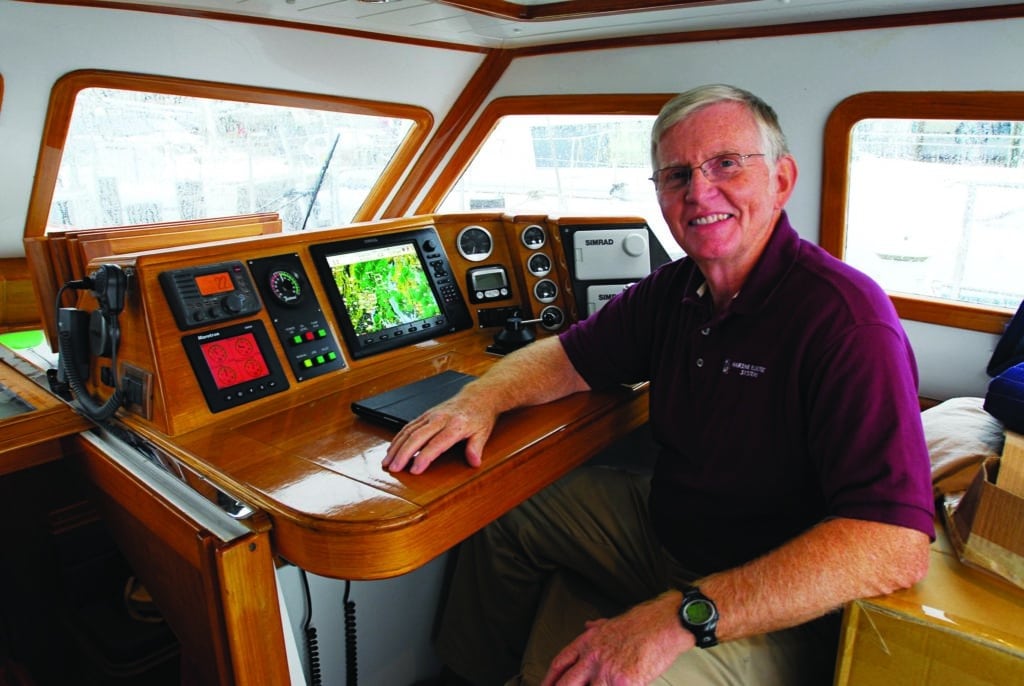
- More: boat maintenance , Electronics , Gear , How To
- More How To

Top Tools for Sailboat Cruising: Must-Have Gear for 2024

Made for Shade: Cockpit Cover Options

Blackwater Wisdom for Holding Tanks

5 DIY Basics For Your Diesel Engine
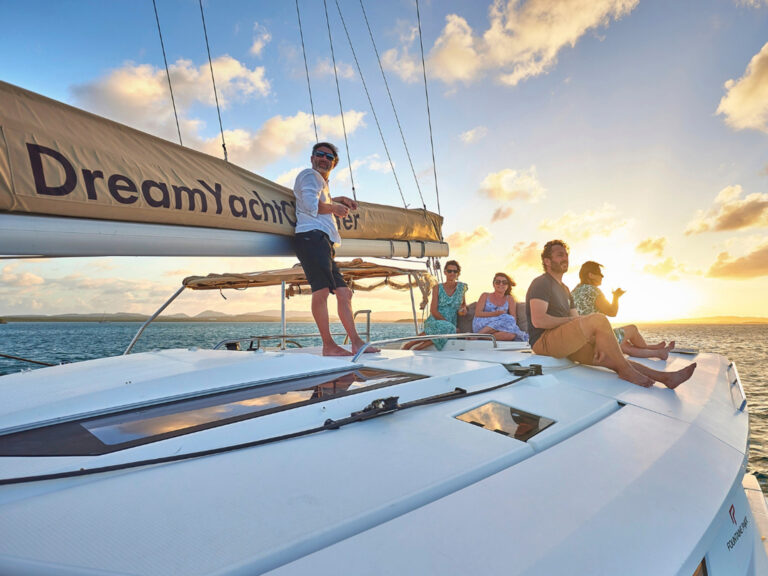
Options To Explore

For Sale: Little Harbor 63 Ketch

Cruising Tahiti: A Party in Paradise
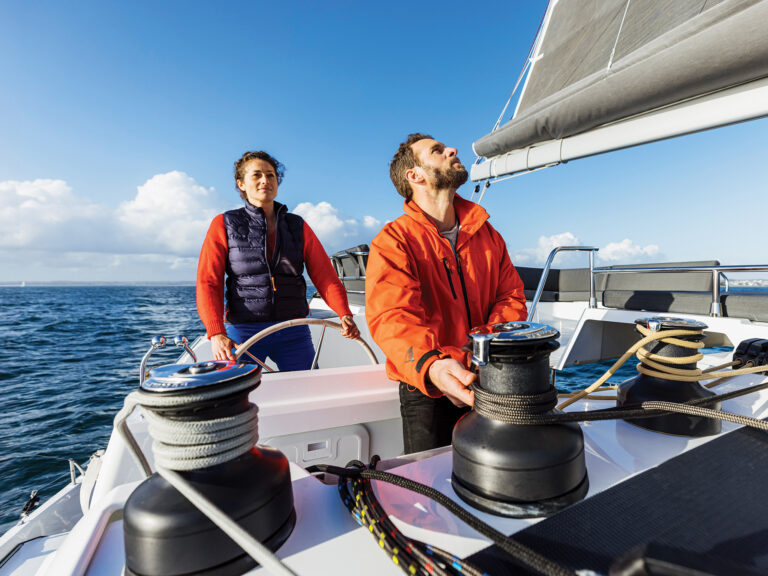
Sailboat Review: Fountaine Pajot Aura 51
- Digital Edition
- Customer Service
- Privacy Policy
- Terms of Use
- Email Newsletters
- Cruising World
- Sailing World
- Salt Water Sportsman
- Sport Fishing
- Wakeboarding

Please verify you are a human
Access to this page has been denied because we believe you are using automation tools to browse the website.
This may happen as a result of the following:
- Javascript is disabled or blocked by an extension (ad blockers for example)
- Your browser does not support cookies
Please make sure that Javascript and cookies are enabled on your browser and that you are not blocking them from loading.
Reference ID: 825fc279-60a4-11ef-9f00-439bf822c8c8
Powered by PerimeterX , Inc.
Practical Boat Owner
- Digital edition

Nav equipment and electronics: how to set up your boat on a budget
- Rupert Holmes
- October 28, 2020
What’s essential when updating your nav station? Rupert Holmes looks at everything from AIS to radar, sonar and MFDs

Marine electronics have come a long way since the days when a log, depth sounder , VHF and GPS, or even Decca, were the norm for many boats. It’s now possible to spend the entire value of an older 25-30ft yacht on electronics and still not have a totally comprehensive system. So what are the best options for those who don’t want to splash large amounts of cash on gizmos?
What’s the least that you need to stay safe? My boat in Greece (pictured above), which I keep to a very basic specification (as much as anything to reduce unnecessary time spent on maintenance) has only fixed and handheld VHFs, plus an EPIRB as dedicated equipment. Both the depth sounder and speed/distance log that I fitted when I bought the boat in 2001 gave up long ago and haven’t been replaced.
Of course it’s important to know the depth when anchoring, but if you approach reasonably slowly it can be fathomed with a lead line. I rarely anchor in more than 10-12m, so this doesn’t need to be particularly long and is therefore easy to use after a bit of practice.
Navigation is done on phone and tablet apps, with the hardware protected by waterproof and shockproof cases. As backup I still have steering and hand-bearing compasses, as well as paper charts. I recently also bought an elderly tiller pilot, which does a much better job, other than when close-hauled, than the length of stout shock cord I’d used for the previous 14 years. More on that later.
In other parts of the world, and especially much of our home waters, a depth sounder is a more fundamental item that few people would want to be without.
The same is true for a speed and distance log when sailing in tidal areas. Beyond these items, with the exception of AIS (and arguably radar for some), there’s a sense in which everything else is merely a matter of convenience or efficiency. Of course, the latter can lead to faster passage making, which naturally some will welcome.
At the other end of the scale are yachts with sensors for a wider range of parameters, including gyro compasses or 9-axis motion sensors, wind speed and angle, AIS transponders, radar, plus on-deck multifunction displays (MFDs) that are enormously more powerful in what they can display than even the very best of old-school chartplotters.
For many, much of this kit is by no means essential, but it makes life much easier, especially approaching an unfamiliar port at night and in the rain. It also aids efficient sailing, whether you’re racing or simply want to knock an hour or two off passage times for longer trips.
Relatively recent software developments that include lay lines to waypoints when tacking towards them and wind graphs that help to spots trends in changes to strength or direction are very helpful in this respect.
How to upgrade my existing navigation instruments?

My preference is to mount an MFD on deck and use a tablet as a repeater at the chart table below
If existing systems are working well it’s often feasible to replace a single component that fails, rather than renewing the entire system. There’s therefore a brisk trade in second-hand displays, sensors and other essential items on ebay.

Another example of instruments fitted in the cockpit
These often change hands at surprisingly high prices for items that may be 15 or more years old, but it can make sense for the buyer if replacing one element postpones renewing an entire system that could cost several thousand pounds to replace.
On the other hand, in many cases paying a high price for second-hand equipment may make little long-term sense for someone wanting to install a system from scratch, unless they are on the tightest of budgets.
In both cases it’s well worth making a realistic assessment of what you actually need. For instance, is a wind instrument absolutely necessary?
Historically wind sensors have been one of the most unreliable elements of marine electronics, which also means working ones are particularly sought after on the second-hand market.
Arguably, the only sense in which wind data is essential is to enable an autopilot to steer to the wind angle. The ability to do this is very important for sailing close hauled (or indeed downwind angles) for any length of time.
In Greece I don’t have wind data for the pilot to use, which is why my length of shock cord works well when close hauled in a consistent breeze, providing the sails are carefully trimmed to make the boat properly balanced.
How resilient is electronic nav equipment? Today’s electronics are far more reliable than in the past, but they’re still by no means infallible. The greater the extent to which you can run the boat without sophisticated electronics, the smaller the chance of being caught out by a big repair bill, or having a weekend or summer cruise spoiled. This applies just as much to a boat with basic electronics as to one with comprehensive systems. Given the number of GPS-enabled devices we now own it’s fairly easy to carry backups, but they do need to have suitable protection against the elements and being accidentally dropped down the companionway or catapulted across the cabin in rough seas.
Should I upgrade to NMEA2000 from NMEA0183?

Few things date the appearance of a boat more than old electronics.
To my mind there’s no contest between the two industry standard protocols for instrument data networks. I’d have to be very skint to contemplate fitting a network from scratch based on the older NMEA0183 standard, which has arrays of tiny wires, along with a limit to the number of devices that can talk or listen on the network. This makes installation of anything beyond a simple log and depth sounder a laborious and fiddly process.

Neat plug-and-play connections on a NMEA2000 system
On the other hand, if you’ve inherited instruments that don’t work with a recently bought boat, time invested in tracing the wiring and making good any problems might be rewarded with working electronics.
The plug and play simplicity of NMEA2000 (sometimes referred to as N2K) makes installation a relative breeze, reliability is greatly improved and when something does go wrong fault-finding is enormously simplified. This system also makes it easier to add additional functionality or displays of all types at a later date.
On the downside, the cables can be eyewateringly expensive.
N2K systems (and the proprietary protocols that work on the same basis) enable individual displays to be used for multiple purposes, rather than being a dedicated depth sounder, log, wind instrument and so on. For instance, a display might be used to show wind data in open water, but changed at the touch of a button to a colour depth graph, plus big numeric read out, when approaching more confined waters.
What is the best autopilot system for my boat?
This is an area in which it’s all but impossible for budget-conscious sailors to avoid big compromises in performance. There have been enormous changes in this field over the past six to eight years and today’s pilots are easier to set up, easier to use and hugely better at holding a course than their predecessors. If properly commissioned, even mid-range systems can be relied on to hold course in challenging conditions, providing you’re not attempting to sail dead downwind.
This is particularly true for wheel-steered boats, with a pilot that drives a below-deck quadrant. These systems are now in general very reliable (though I’d certainly want to take a spare if crossing an ocean), while a growing range of inputs, including those from 9-axis sensors that measure rate of yaw and changes in heel angle, have helped to transform course keeping. A rudder angle sensor is also an important element for these systems, as knowledge of the helm angle helps the course computer’s algorithms steer more accurately.
Tiller-steered boats that don’t have a quadrant below deck are therefore at a significant disadvantage in this respect, although the Canadian-produced Octopus cable drive can offer a solution that’s almost as good as the best below-deck wheel pilots. Pelagic, a relatively recently developed Californian brand, may also be worth considering.
Beyond this, there has been little development of tiller pilots for more than 20 years and the all-in-one type is difficult to waterproof effectively. Raymarine’s EV100 tiller pilot, in which the drive is separate from the course computer and sensor inputs, is the best option, though it lacks a clutch, so has to be manually moved on and off the tiller, and rudder angle feedback is not available.
Brief buyer’s guide to multifunction displays and chartplotters

B&G Zeus 3: the latest systems are hugely powerful and flexible, but can be expensive
The humble standalone chartplotter has morphed into more powerful and sophisticated networked devices that combine a computer processor and software with a display.
As a result, as well as showing charts, all other system data can be displayed, while output from networked AIS and radar units can be overlaid on the chart to make this information easier to interpret. This is perhaps the biggest single difference between a system that might have been installed 15 years ago and today’s marine electronics.
Many MFDs of the last five years have a built-in wifi hub so that the screen can be mirrored onto a tablet or iPad.
Alternatively a separate wifi hub can be added to most NMEA2000 systems to achieve the same result. A common question is whether it’s better to mount the MFD at the chart table and use the tablet on deck, or vice versa?
There’s a good reason why I’d always opt to fit the MFD on deck. Firstly they tend to have good sunlight readable displays, with the latest models particularly good in this respect. By contrast, with the exception of a handful of ruggedised (and relatively expensive) devices, smartphone and tablet screens are notoriously difficult to read in bright sun, although later high-spec models are certainly better in this respect.
The same applies at night, where many apps fail to dim the screen sufficiently to prevent night vision being eliminated. Phones and tablets are also difficult to operate in properly wet conditions when on deck, while the screens of MFDs, particularly more recent models, are significantly better.

An active radar reflector will ensure your boat shows as a clear target on radar
Do I need AIS and radar for my boat?
These two technologies can be extremely useful for avoiding collision in poor visibility and if decisions need to be made at a long range, such as when crossing the English Channel’s busy shipping lanes. Historically, radar was also heavily used as a navigation aid.
Radar has the benefit of equipping your boat to directly detect other vessels and hazards, whereas you can only see AIS targets from craft that are actively transmitting their own signal. Given that only commercial craft over 300 tons, and in the EU fishing vessels of more than 15m length, are required to carry AIS transponders you may encounter many craft without.
If budget only allows you to fit one system there are strong arguments in favour of radar. However, it’s vital to appreciate the downsides before making a decision. Getting the most out of radar is a skilled and time-consuming task, while skimping this role risks adding to the already long list of radar assisted collisions.
Fitting radar without AIS therefore only makes sense for vessels that are crewed by a number of people who have the benefit of proper training in the use of radar and plenty of experience, including at night and in restricted visibility. However, that’s not how most of us sail – even those with the knowledge to use radar effectively may be standing watch alone, or managing a crew that’s at risk of becoming cold, tired and seasick.
This is when AIS scores highly. Key data, including Closest Point of Approach (CPA) and time to CPA, are calculated and accessed easily for every target. In addition, if your boat is fitted with an AIS transponder, other vessels will be able to see your location, course and speed.
Of course, if you have the budget, buy both radar and an AIS transponder. Today’s radar systems are particularly good – they are easier to use and there’s far less chance of over-zealous manual application of rain and wave clutter controls completely tuning out important targets. Having said that, before fitting radar I’d add a radar target enhancer. This device amplifies the reflection of radar signals from other vessels and therefore means your boat is far more likely to show as a clear target.
Do I need sonar for my boat?
This is very much an optional extra, but could be of interest to those keen on fishing, or scoping out new anchorages. There’s been a lot of recent development in this area, both in standalone products and those that can be interfaced with an MFD, thanks to the enormous fishing market in North America.
Low cost systems, with prices starting from as little as £200, tend to have a transducer mounted on the stern of the boat that shows targets out to each side. The very best systems now have sufficient resolution to show patches of sea grass in an anchorage.
Forward-looking sonar tends to be more limited in its scope and is not a budget buy, with typical prices upwards of £700. It can scan a 15° arc to show depths up to 90m ahead of the boat, although gently shelving mud may bring the viable range in shallow water down to as little as 25m.
This article was originally published in PBO Summer 2020 – Subscribe or buy a single issue from www.magazinesdirect.com

- Search forums
Follow along with the video below to see how to install our site as a web app on your home screen.
Note: This feature currently requires accessing the site using the built-in Safari browser.
- AudioKarma Audio Forums
Akai 4000db motorboating
- Thread starter Oceanotter
- Start date Apr 16, 2021
- Tags 4000db akai motorboating popping solved
- Apr 16, 2021
Greetings! I picked up an akai 4000db on ebay a few weeks back that was cleaned but had some electrical issues otherwise it all functions normally. When I first got it the left channel wouldn't record until the machine had been powered on for awhile but it played back fine and there's this consistent popping or "motorboating" as I'm told in the signal. It sounds worse on the right than it does on the left. Since then I've recapped the preamp, the recording preamp (dolby pcb), the power supply also. I've also replaced the troublesome transistors and one LD3141 for the left channel (on the right side of the preamp pcb not the side with the transformers) . The belts are new too. Since I've done this I have motorboating on the right channel when set to source but not on tape. Recording on tape seems to carry the issue through but it doesn't sound as obvious. The left channel has some slight motorboating (pop pop pop pop pop etc...) but it's definitely less obvious. I'm waiting on my LD3141. Replacements to arrive as I intended to replace them all and just have a completely fresh and newly restored deck to call my own but before I replace them I figured I'd ask if anyone out there might know of anything I should be checking to ensure this motorboating issue goes away as I feel while maybe the ld3141s could be the issue it could also be something else too. Also! Does anyone know what's up with the 7 1/2 equalizer on this deck sounding like crap? It sounds muddy. Far less bright than the 3 inch eq and I'm wondering if thsts by design or if somethings not calibrated right. So yeah that's about it. Motoboarding on left (slight) and right (lots) even after all caps and transistors were replaced except for 3 ld3141s. Shows up monitoring source but not on tape. Shows up in recorded samples but not quite as pronounced. Bless!
Jonesin' for audio
Sorry if this is sounds like a dumb question but you’re plugged in through a tape monitor loop on your amp or receiver, right? If you’re plugged into a regular line level input like aux or cd in then you will get internal feedback that sounds like motorboating whenever you go to source and have the selector set for the tape deck. Unfortunately the tape loop has been eliminated on most modern gear so you have to monitor through headphones plugged directly into the deck and make sure the deck is set to Tape not Source before changing the input selector on your amp or receiver. If you’re using gear with a tape monitor loop and the deck is plugged in through it then disregard.
Oh! Actually I'll have to try this tonight. I have a modern receiver plugged into CD but I have an older one with a tape input I'll give a shot tonight. It'd be silly if that was the issue the entire time and hopefully it was.
audiojones said: Sorry if this is sounds like a dumb question but you’re plugged in through a tape monitor loop on your amp or receiver, right? If you’re plugged into a regular line level input like aux or cd in then you will get internal feedback that sounds like motorboating whenever you go to source and have the selector set for the tape deck. Unfortunately the tape loop has been eliminated on most modern gear so you have to monitor through headphones plugged directly into the deck and make sure the deck is set to Tape not Source before changing the input selector on your amp or receiver. If you’re using gear with a tape monitor loop and the deck is plugged in through it then disregard. Click to expand...
- Apr 17, 2021
Anyone else have any ideas?
Super Member
Only on monitor you say? Might be some grounding issue with the "input" channel maybe. Have you tried several input devices? Or the monitor switch could be bad.
Okke 70s said: Only on monitor you say? Might be some grounding issue with the "input" channel maybe. Have you tried several input devices? Or the monitor switch could be bad. Click to expand...
On mine half the flip switches where dodgy. Good idea to go over those anyway. If I connect a mobile phone to some amps it also makes noise. Must be some digital signal, or static. It stops the moment that 'play' is pressed.
Fish fingers and custard!
Clean the record switch.
- Apr 18, 2021
Thanks for the advice everyone. I'm gonna thoroughly clean all this switches and see where that gets me. And I'll report back!
- Apr 19, 2021
I've solved the issue. Cleaning the switches didn't fix it but it did help reduce the noise. I realized that it might be a grounding issue so I applied a screw driver to the case and voila the noise went away almost entirely. I realized since I didn't have the unit entirely reassembled that might be the case and Lo and behold that did the trick. Thank you all for your help!
Similar threads
- Mar 18, 2013
- Aug 13, 2017
- Nov 18, 2017
- Oct 1, 2019
- Sep 23, 2022

IMAGES
COMMENTS
Motorboating (electronics) In electronics, motorboating is a type of low frequency parasitic oscillation (unwanted cyclic variation of the output voltage) that sometimes occurs in audio and radio equipment and often manifests itself as a sound similar to an idling motorboat engine, a "put-put-put", in audio output from speakers or earphones ...
Motorboating is a low frequency oscillation. There are numerous causes. Many are related to capacitors or high impedance power supplies (flat batteries). You need to look at the supply rails to see if they are fluctuating in time to with the motorboating because one cause is coupling between the amplifier and the power supply -- this can ...
Disconnect the top of the upper 100k. Connect a 10k resistor to the 12V supply. Connect a big capacitor, say 100 uF from the other end of that 10k to ground, then connect the top of that upper 100k to the top of that new capacitor. If it still motorboats increase the RC time constant of your new filter.
The 6BQ5 screen shouldn't be connected to the same power supply node as the 12AX7s - it draws more current than they do, so variation in screen current makes the supply voltage change, which makes the plate voltage on the first stage change, which gets amplified by the following two stages.. and the screen current changes some more.
Final Thoughts. Understanding basic boat electronics is crucial for the safety, performance, and enjoyment of your boating experience. For beginners, investing in a reliable GPS chartplotter, VHF radio, and AIS system is an excellent place to start. As you become more experienced and confident on the water, you may choose to add advanced ...
In electronics, motorboating is a type of low frequency parasitic oscillation that sometimes occurs in audio and radio equipment and often manifests itself as a sound similar to an idling motorboat engine, a "put-put-put", in audio output from speakers or earphones. It is a problem encountered particularly in radio transceivers and older vacuum tube audio systems, guitar amplifiers, PA systems ...
Navionics digital cartography is known for its level of detail and ease of use. Garmin bought the mapmaker in 2017, but only now has fully integrated Navionics charts across its entire line of Garmin GPSMAP units (look for Garmin Navionics+ and Garmin Navionics Vision+). From the diminutive 743xsv to the movie-screen-like 8624 models, these now ...
Motorboating (electronics) explained. In electronics, motorboating is a type of low frequency parasitic oscillation (unwanted cyclic variation of the output voltage) that sometimes occurs in audio and radio equipment and often manifests itself as a sound similar to an idling motorboat engine, a "put-put-put", in audio output from speakers or ...
Furuno TZT22X and TZT24X. Furuno TZTouch3 units grow for the 2023 model year. Literally. The new TZT22X and TZT24X offer 22- and 24-inch screen sizes with full HD 1920 x 1080 in-plane switching LCDs. They can integrate seamlessly with existing TZTouch3 systems, and boast some serious speed and power thanks to quad-core processors.
The new Motorboat Electrical and Electronics Manual covers all inboard engine boats, from 20A to 120A, coastal, inshore, and blue-water vessels. This complete guide to the electrical systems and the electronics for large and small pleasure boats and workboats is a must for all builders, owners and operators, whether they are concerned with new ...
In fact, electronics have taken tasks like navigation, which once required years of learning to master, and made them as simple as pressing a few buttons or swiping on a touch screen.There are still some rather complex tasks and gear involved when one considers operating some large vessels, but for the average recreational boat owner the list of electronics you'll need to learn about is ...
The term motorboating is applied to oscillations whose frequency is below the range of hearing, from 1 to 10 hertz, so the individual osci. In electronics, motorboating is a type of low frequency parasitic oscillation (unwanted cyclic variation of the output voltage) that sometimes occurs in audio and radio equipment and often manifests itself ...
271. Location. Smyrna, Tennessee. Jul 15, 2010. #6. zz0468 said: "motorboating" is a low frequency oscillation that resembles a motorboat putt-putting along. The term predates anything digital by about 6 decades or so. Did motorboating have the same meaning BEFORE digital, but not caused by digital apparatus?
Kenny Rogers knows when to hold em, knows when to fold em. When it comes to a boat electronic upgrades, we should learn to do the same. Modern boat electronics provide a great benefit to sailors when it comes to navigation, weather, collision avoidance or just the plain fun of being under sail. So it's no surprise that we cruisers regularly ...
Brands offered include ACR Electronics, McMurdo and Ocean Signal. Navigation Electronics. Whether you are planning to navigate a river, cross a lake or circumnavigate the world, at West Marine, you will find an outstanding selection of electronics for navigation and situational awareness. Online and in our stores, boaters find marine handheld ...
The pre-amp is powered by the 12v adapter, the amp is a standard cambridge audio A1 amp. The preamp has a very high fixed gain of 100 and the volume control is at its output, not at its input. The input to the preamp is probably overloaded by line level from a PC but the preamp is probably designed to use a dynamic microphone for its input.
Rupert Holmes looks at everything from AIS to radar, sonar and MFDs. Marine electronics have come a long way since the days when a log, depth sounder, VHF and GPS, or even Decca, were the norm for many boats. It's now possible to spend the entire value of an older 25-30ft yacht on electronics and still not have a totally comprehensive system.
As a kid, I built many amplifiers, with 4 or 5 or 6 stages gain, that oscillated because of VDD resistance (and impedance). When I added 5,000uF capacitors, installed directly at the final stage (that drove 1Kohm earphones), the motorboating finally ended and I could hear the thermal noise. \$\endgroup\$ -
Apr 16, 2021. #1. Greetings! I picked up an akai 4000db on ebay a few weeks back that was cleaned but had some electrical issues otherwise it all functions normally. When I first got it the left channel wouldn't record until the machine had been powered on for awhile but it played back fine and there's this consistent popping or "motorboating ...
Astrakhan Oblast ( Russian: Астраха́нская о́бласть, romanized : Astrakhanskaya oblastʹ; Kazakh: Астрахан облысы, romanized : Astrahan oblysy) is a federal subject of Russia (an oblast) located in southern Russia. Its administrative center is the city of Astrakhan. As of the 2010 Census, its population was ...
Lake Baskunchak (Russian: Баскунчак; Kazakh: Басқұншақ, romanized: Basqunshaq) is a salt lake of 115 km 2 in Astrakhan Oblast, Russia, located at , about 270 km north of the Caspian Sea, and 53 km east of the Since 1997, the area is protected as part of the Bogdinsko-Baskunchakski Nature Reserve.. The surface elevation of the lake is 21 m below sea level.
Kapustin Yar (air base) / 48.66778°N 45.73167°E / 48.66778; 45.73167. Kapustin Yar is a military airfield near the town of Znamensk, Astrakhan Oblast, serving the Kapustin Yar military training ground, founded in 1946. Until the 1990s, the airfield had the code name "Picture" (previously - "Constitution"). Classed as an Airfield 3rd ...
Top Astrakhan Specialty Museums: See reviews and photos of Specialty Museums in Astrakhan, Russia on Tripadvisor.